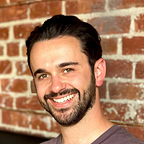Hearken To The People — It Is By Their Will That You Publish
The word hearken appears over 250 times in the Bible so it seems fitting that the harbinger of public powered journalism is a company which goes by that name.
Hearken, co-founded by Jennifer Brandel and Corey Haines, is sort of like the Moses of modern day journalism. It’s a tool that let’s journalists ask their audience questions and poll them. It’s also wresting journalists from capitulation to the outdated methodology atop which legacy media sits and bringing them to the promised land, public-powered journalism.
The outdated methodology is reactive or press initiated journalism, where a cadre of media professionals react to an event or come up with an idea for what they think will be an interesting story. The promised land is public-powered journalism. Brandel introduced the concept in a Medium post last year (emphasis Brandel’s):
[Public-powered journalism is] that the public gets a direct say, and actual direct power in what journalists are reporting on. People (who are not journalists) get to put forward what they want to know, and there’s a process for newsrooms to respond accordingly.
Much like Moses, Hearken has detractors (“The audience will want to hear about the Kardashians!”) and worshippers of false gods (“All hail journalistic objectivity!”). While the view of the promised land suggests fertile soil and resources aplenty, seeing the value does not lead to extracting that value in the form of stable incomes and news industry sustainability. That will come after journalists wander around the desert for a few years, eating food from questionable sources and hitting their fax machines to make them work instead of speaking gently to them as their I.T. gods command.
The philosophy behind Hearken is clearly the evolution of journalism.
S. Mitra Kalita, managing editor for editorial strategy at the Los Angeles Times, told our class of social journalism students that journalists should think about the things people do and explain them or debunk them. How can we do that if we do not have a way to interact with our audience?
For years, media professionals have set the agenda. For years, trust in mass media has been on the decline. That downward trend is happening for many reasons but I would contend that one of them is because of the bubble many journalists purposefully try to live in. That bubble is a false sense of objectivity and a blissful ignorance in the belief that they have righteously inherited the duties and burden of the fourth estate of old.
The power of the fourth estate is nothing without the power of the people. Journalists must prove to the public that they are not mouthpieces for the powerful and that they are worth more than the punditocracy that crowds television news.
Hearken is doing journalists the service of providing a tool to do just that. It is time we hearken to the people — it is by their will that we exist.
Questions for my classmates:
- In the Hearken Process, pictured below, the steps of creating a module, engaging the community, and collecting questions are equidistant. Those jumps seem like they would be the most difficult to make. How would you go about engaging a community other than just embedding the module on a website?
- In the next few months, Brandel and her team will be enhancing Hearken and developing new capabilities for the platform. What would you like to see added to Hearken?
